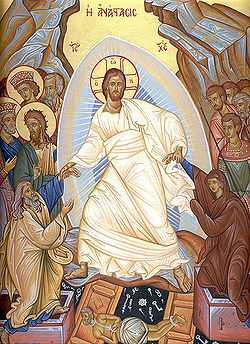
Easter, also called Pasch or Resurrection Sunday,is a festival and holiday celebrating the resurrection of Jesus Christ from the dead, described in the New Testament as having occurred on the third day of his burial after his crucifixion by Romans at Calvary . 30 AD. It is the culmination of the Passion of Christ, preceded by Lent (or Great Lent), a forty-day period of fasting, prayer, and penance.
The week before Easter is called Holy Week, and it contains the days of the Easter Triduum, including Maundy Thursday, commemorating the Maundy and Last Supper,as well as Good Friday, commemorating the crucifixion and death of Jesus.In western Christianity, Eastertide, the Easter Season, begins on Easter Sunday and lasts seven weeks, ending with the coming of the fiftieth day, Pentecost Sunday. In Orthodoxy, the season of Pascha begins on Pascha and ends with the coming of the fortieth day, the Feast of the Ascension.
Easter and the holidays that are related to it are movable feasts which do not fall on a fixed date in the Gregorian or Julian calendars which follow only the cycle of the sun; rather, its date is determined on a lunisolar calendar similar to the Hebrew calendar. The First Council of Nicaea (325) established two rules, independence of the Jewish calendar and worldwide uniformity, which were the only rules for Easter explicitly laid down by the council. No details for the computation were specified; these were worked out in practice, a process that took centuries and generated a number of controversies. It has come to be the first Sunday after the ecclesiastical full moon that occurs on or soonest after 21 March, but calculations vary in East and West.
Easter is linked to the Jewish Passover by much of its symbolism, as well as by its position in the calendar. In many languages, the words for "Easter" and "Passover" are identical or very similar. Easter customs vary across the Christian world, and include sunrise services, exclaiming the Paschal greeting, clipping the church, and decorating Easter eggs, a symbol of the empty tomb.The Easter lily, a symbol of the resurrection, traditionally decorates the chancel area of churches on this day and for the rest of Eastertide. Additional customs that have become associated with Easter and are observed by both Christians and some non-Christians include egg hunting, the Easter Bunny, and Easter parades.There are also various traditional Easter foods that vary regionally.
The New Testament states that the resurrection of Jesus, which Easter celebrates, is a foundation of the Christian faith. The resurrection established Jesus as the powerful Son of God and is cited as proof that God will judge the world in righteousness. For those who trust in Jesus' death and resurrection, "death is swallowed up in victory." Any person who chooses to follow Jesus receives "a new birth into a living hope through the resurrection of Jesus Christ from the dead". Through faith in the working of God those who follow Jesus are spiritually resurrected with him so that they may walk in a new way of life and receive eternal salvation.
Easter is linked to the Passover and Exodus from Egypt recorded in the Old Testament through the Last Supper, sufferings and crucifixion of Jesus that preceded the resurrection. According to the New Testament, Jesus gave the Passover meal a new meaning, as in the upper room during the Last Supper he prepared himself and his disciples for his death. He identified the matzah and cup of wine as his body soon to be sacrificed and his blood soon to be shed. Paul states, "Get rid of the old yeast that you may be a new batch without yeast—as you really are. For Christ, our Passover lamb, has been sacrificed". this refers to the Passover requirement to have no yeast in the house and to the allegory of Jesus as the Paschal lamb.
One interpretation of the Gospel of John is that Jesus, as the Passover lamb, was crucified at roughly the same time as the Passover lambs were being slain in the temple, on the afternoon of Nisan 14. The scriptural instructions specify that the lamb is to be slain "between the two evenings", that is, at twilight. By the Roman period, however, the sacrifices were performed in the mid-afternoon. Josephus, Jewish War 6.10.1/423 ("They sacrifice from the ninth to the eleventh hour"). Philo, Special Laws 2.27/145 ("Many myriads of victims from noon till eventide are offered by the whole people").
This interpretation, however, is inconsistent with the chronology in the Synoptic Gospels. It assumes that text literally translated "the preparation of the Passover" in John 19:14 refers to Nisan 14 (Preparation Day for the Passover) and not necessarily to Yom Shishi (Friday, Preparation Day for the Passover week Sabbath)[and that the priests' desire to be ritually pure in order to "eat the Passover"refers to eating the Passover lamb, not to the public offerings made during the days of Unleavened Bread


0 Response to "All you need to know about Easter."
Post a Comment
We love to hear from you!
Sign in to comment "anonymously" without entering verification text.
Want to be notified when I reply your comment? Tick the "Notify Me" box.